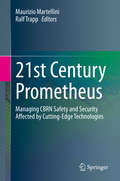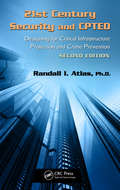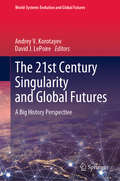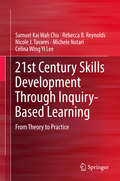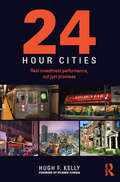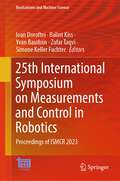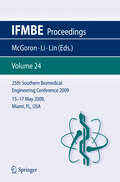- Table View
- List View
21st Century Nanoscience – A Handbook: Design Strategies for Synthesis and Fabrication (Volume Two) (21st Century Nanoscience)
by Klaus D. SattlerThis up-to-date reference is the most comprehensive summary of the field of nanoscience and its applications. It begins with fundamental properties at the nanoscale and then goes well beyond into the practical aspects of the design, synthesis, and use of nanomaterials in various industries. It emphasizes the vast strides made in the field over the past decade – the chapters focus on new, promising directions as well as emerging theoretical and experimental methods. The contents incorporate experimental data and graphs where appropriate, as well as supporting tables and figures with a tutorial approach.
21st Century Prometheus: Managing CBRN Safety and Security Affected by Cutting-Edge Technologies
by Maurizio Martellini Ralf TrappThis book describes the evolving CBRN risk landscape and highlights advances in the “core” CBRN technologies, including when combined with (improvised) explosive devices (CBRNe threats). It analyses how associated technologies create new safety and security risks, challenging certain assumptions that underlie current control regimes. The book also shows how technologies can be enablers for more effective strategies to mitigate these risks.21st-century safety and security risks emanating from chemical, biological, radiological and nuclear materials – whether resulting from natural events, accidents or malevolent use - are increasingly shaped by technologies that enable their development, production or use in ways that differ from the past. Artificial intelligence, the use of cyberspace, the revolution in the life sciences, new manufacturing methods, new platforms and equipment for agent delivery, hypersonic weapons systems, information tools utilised in hybrid warfare – these and other technologies are reshaping the global security environment and CBRN landscape. They are leading to a growing potential for highly targeted violence, and they can lead to greater instability and vulnerability worldwide. At the same time, technology offers solutions to manage CBRN risks. Examples are faster detection, more accurate characterisation of the nature and origin of CBRN agents, new forensic investigation methods, or new medical treatments for victims of CBRN incidents. New educational concepts help to foster a culture of responsibility in science and technology and strengthen governance. New training methods help develop practical skills to manage CBRN risks more effectively.The book concludes that there is a growing need for a holistic framework towards CBRN risk mitigation. Traditional arms control mechanisms such as global, regional or bilateral treaties and export controls are still needed, as they provide a necessary legal and institutional framework. But laws and technology denial alone will not suffice, and institutional mechanisms can at times be weak. Given the pace of technological progress and the diffusion of critical knowledge, tools and materials, policymakers must accept that CBRN risks cannot be eliminated altogether. Instead, society has to learn to manage these risks and develop resilience against them. This requires a “softer”, broadly based multi-stakeholder approach involving governments, industry, the research and development communities, educators, and civil society. Furthermore, educating policymakers that cutting-edge technologies may seriously affect global strategic stability could create incentives for developing a more creative and contemporary arms control strategy that fosters cooperation rather than incremental polarisation.
21st Century Security and CPTED: Designing for Critical Infrastructure Protection and Crime Prevention, Second Edition
by Randall I. AtlasThe concept of Crime Prevention Through Environmental Design (CPTED) has undergone dramatic changes over the last several decades since C. Ray Jeffery coined the term in the early 1970s, and Tim Crowe wrote the first CPTED applications book. The second edition of 21st Century Security and CPTED includes the latest theory, knowledge, and practice of
The 21st Century Singularity and Global Futures: A Big History Perspective (World-Systems Evolution and Global Futures)
by Andrey V. Korotayev David J. LePoireThis book introduces a 'Big History' perspective to understand the acceleration of social, technological and economic trends towards a near-term singularity, marking a radical turning point in the evolution of our planet. It traces the emergence of accelerating innovation rates through global history and highlights major historical transformations throughout the evolution of life, humans, and civilization. The authors pursue an interdisciplinary approach, also drawing on concepts from physics and evolutionary biology, to offer potential models of the underlying mechanisms driving this acceleration, along with potential clues on how it might progress. The contributions gathered here are divided into five parts, the first of which studies historical mega-trends in relation to a variety of aspects including technology, population, energy, and information. The second part is dedicated to a variety of models that can help understand the potential mechanisms, and support extrapolation. In turn, the third part explores various potential future scenarios, along with the paths and decisions that are required. The fourth part presents philosophical perspectives on the potential deeper meaning and implications of the trend towards singularity, while the fifth and last part discusses the implications of the Search for Extraterrestrial Intelligence (SETI). Given its scope, the book will appeal to scholars from various disciplines interested in historical trends, technological change and evolutionary processes.
21st Century Skills Development Through Inquiry-Based Learning: From Theory to Practice
by Samuel Kai Chu Rebecca B. Reynolds Nicole J. Tavares Michele Notari Celina Wing LeeThis book presents innovative instructional interventions designed to support inquiry project-based learning as an approach to equip students with 21st century skills. Instructional techniques include collaborative team-based teaching, social constructivist game design and game play, and productive uses of social media such as wikis and other online communication affordances. The book will be of interest to researchers seeking a summary of recent empirical studies in the inquiry project-based learning domain that employ new technologies as constructive media for student synthesis and creation. The book also bridges the gap between empirical works and a range of national- and international-level educational standards frameworks such as the P21, the OECD framework, AASL Standards for the 21st Century Learner, and the Common Core State Standards in the US. Of particular interest to education practitioners, the book offers detailed descriptions of inquiry project-based learning interventions that can be directly reproduced in today's schools. Further, the book provides research-driven guidelines for the evaluation of student inquiry project-based learning. Lastly, it offers education policymakers insight into establishing anchors and spaces for applying inquiry project-based learning opportunities for youth today in the context of existing and current education reform efforts. The aim of this book is to support education leaders', practitioners' and researchers' efforts in advancing inspiring and motivating student learning through transformative social constructivist inquiry-based knowledge-building with information technologies. We propose that preparing students with inquiry mindsets and dispositions can promote greater agency, critical thinking and resourcefulness, qualities needed for addressing the complex societal challenges they may face.
22. Internationales Stuttgarter Symposium: Automobil- und Motorentechnik (Proceedings)
by Michael Bargende Hans-Christian Reuss Andreas WagnerBand IIIn einer sich rasant verändernden Welt sieht sich die Automobilindustrie fast täglichmit neuen Herausforderungen konfrontiert: Der problematischer werdende Rufdes Dieselmotors, verunsicherte Verbraucher durch die in der Berichterstattungvermischte Thematik der Stickoxid- und Feinstaubemissionen, zunehmendeKonkurrenz bei Elektroantrieben durch neue Wettbewerber, die immer schwierigerwerdende öffentlichkeitswirksame Darstellung, dass ein großer Unterschiedzwischen Prototypen, Kleinserien und einer wirklichen Großserienproduktion besteht.Dazu kommen noch die Fragen, wann die mit viel finanziellem Einsatz entwickeltenalternativen Antriebsformen tatsächlich einen Return of Invest erbringen, wer dienotwendige Ladeinfrastruktur für eine Massenmarkttauglichkeit der Elektromobilitätbauen und finanzieren wird und wie sich das alles auf die Arbeitsplätzeauswirken wird.Für die Automobilindustrie ist es jetzt wichtiger denn je, sich den Herausforderungenaktiv zu stellen und innovative Lösungen unter Beibehaltung des hohenQualitätsanspruchs der OEMs in Serie zu bringen. Die Hauptthemen sind hierbei,die Elektromobilität mit höheren Energiedichten und niedrigeren Kosten der Batterienvoranzutreiben und eine wirklich ausreichende standardisierte und zukunftssichereLadeinfrastruktur darzustellen, aber auch den Entwicklungspfad zum schadstofffreienund CO2-neutralen Verbrennungsmotor konsequent weiter zu gehen. Auch dasautomatisierte Fahren kann hier hilfreich sein, weil das Fahrzeugverhalten dann –im wahrsten Sinne des Wortes - kalkulierbarer wird.Dabei ist es für die etablierten Automobilhersteller strukturell nicht immer einfach,mit der rasanten Veränderungsgeschwindigkeit mitzuhalten. Hier haben Start-upseinen großen Vorteil: Ihre Organisationsstruktur erlaubt es, frische, unkonventionelleIdeen zügig umzusetzen und sehr flexibel zu reagieren. Schon heute werdenStart-ups gezielt gefördert, um neue Lösungen im Bereich von Komfort, Sicherheit,Effizienz und neuen Kundenschnittstellen zu finden. Neue Lösungsansätze,gepaart mit Investitionskraft und Erfahrungen, bieten neue Chancen auf dem Weg derElektromobilität, der Zukunft des Verbrennungsmotors und ganz allgemein für dasAuto der Zukunft.
22. Internationales Stuttgarter Symposium: Automobil- und Motorentechnik (Proceedings)
by Michael Bargende Hans-Christian Reuss Andreas WagnerBand IIn einer sich rasant verändernden Welt sieht sich die Automobilindustrie fast täglichmit neuen Herausforderungen konfrontiert: Der problematischer werdende Rufdes Dieselmotors, verunsicherte Verbraucher durch die in der Berichterstattungvermischte Thematik der Stickoxid- und Feinstaubemissionen, zunehmendeKonkurrenz bei Elektroantrieben durch neue Wettbewerber, die immer schwierigerwerdende öffentlichkeitswirksame Darstellung, dass ein großer Unterschiedzwischen Prototypen, Kleinserien und einer wirklichen Großserienproduktion besteht.Dazu kommen noch die Fragen, wann die mit viel finanziellem Einsatz entwickeltenalternativen Antriebsformen tatsächlich einen Return of Invest erbringen, wer dienotwendige Ladeinfrastruktur für eine Massenmarkttauglichkeit der Elektromobilitätbauen und finanzieren wird und wie sich das alles auf die Arbeitsplätzeauswirken wird.Für die Automobilindustrie ist es jetzt wichtiger denn je, sich den Herausforderungenaktiv zu stellen und innovative Lösungen unter Beibehaltung des hohenQualitätsanspruchs der OEMs in Serie zu bringen. Die Hauptthemen sind hierbei,die Elektromobilität mit höheren Energiedichten und niedrigeren Kosten der Batterienvoranzutreiben und eine wirklich ausreichende standardisierte und zukunftssichereLadeinfrastruktur darzustellen, aber auch den Entwicklungspfad zum schadstofffreienund CO2-neutralen Verbrennungsmotor konsequent weiter zu gehen. Auch dasautomatisierte Fahren kann hier hilfreich sein, weil das Fahrzeugverhalten dann –im wahrsten Sinne des Wortes - kalkulierbarer wird.Dabei ist es für die etablierten Automobilhersteller strukturell nicht immer einfach,mit der rasanten Veränderungsgeschwindigkeit mitzuhalten. Hier haben Start-upseinen großen Vorteil: Ihre Organisationsstruktur erlaubt es, frische, unkonventionelleIdeen zügig umzusetzen und sehr flexibel zu reagieren. Schon heute werdenStart-ups gezielt gefördert, um neue Lösungen im Bereich von Komfort, Sicherheit,Effizienz und neuen Kundenschnittstellen zu finden. Neue Lösungsansätze,gepaart mit Investitionskraft und Erfahrungen, bieten neue Chancen auf dem Weg derElektromobilität, der Zukunft des Verbrennungsmotors und ganz allgemein für dasAuto der Zukunft.
22nd Annual Conference on Composites, Advanced Ceramics, Materials, and Structures - A (Ceramic Engineering and Science Proceedings #218)
by Don E. BrayThis volume is part of the Ceramic Engineering and Science Proceeding (CESP) series. This series contains a collection of papers dealing with issues in both traditional ceramics (i.e., glass, whitewares, refractories, and porcelain enamel) and advanced ceramics. Topics covered in the area of advanced ceramic include bioceramics, nanomaterials, composites, solid oxide fuel cells, mechanical properties and structural design, advanced ceramic coatings, ceramic armor, porous ceramics, and more.
22nd Annual Conference on Composites, Advanced Ceramics, Materials, and Structures - B (Ceramic Engineering and Science Proceedings #220)
by Don E. BrayThis volume is part of the Ceramic Engineering and Science Proceeding (CESP) series. This series contains a collection of papers dealing with issues in both traditional ceramics (i.e., glass, whitewares, refractories, and porcelain enamel) and advanced ceramics. Topics covered in the area of advanced ceramic include bioceramics, nanomaterials, composites, solid oxide fuel cells, mechanical properties and structural design, advanced ceramic coatings, ceramic armor, porous ceramics, and more.
23. Internationales Stuttgarter Symposium: Automobil- und Motorentechnik (Proceedings)
by FkfsBand IIn einer sich rasant verändernden Welt sieht sich die Automobilindustrie fast täglichmit neuen Herausforderungen konfrontiert: Der problematischer werdende Rufdes Dieselmotors, verunsicherte Verbraucher durch die in der Berichterstattungvermischte Thematik der Stickoxid- und Feinstaubemissionen, zunehmendeKonkurrenz bei Elektroantrieben durch neue Wettbewerber, die immer schwierigerwerdende öffentlichkeitswirksame Darstellung, dass ein großer Unterschiedzwischen Prototypen, Kleinserien und einer wirklichen Großserienproduktion besteht.Dazu kommen noch die Fragen, wann die mit viel finanziellem Einsatz entwickeltenalternativen Antriebsformen tatsächlich einen Return of Invest erbringen, wer dienotwendige Ladeinfrastruktur für eine Massenmarkttauglichkeit der Elektromobilitätbauen und finanzieren wird und wie sich das alles auf die Arbeitsplätzeauswirken wird.Für die Automobilindustrie ist es jetzt wichtiger denn je, sich den Herausforderungenaktiv zu stellen und innovative Lösungen unter Beibehaltung des hohenQualitätsanspruchs der OEMs in Serie zu bringen. Die Hauptthemen sind hierbei,die Elektromobilität mit höheren Energiedichten und niedrigeren Kosten der Batterienvoranzutreiben und eine wirklich ausreichende standardisierte und zukunftssichereLadeinfrastruktur darzustellen, aber auch den Entwicklungspfad zum schadstofffreienund CO2-neutralen Verbrennungsmotor konsequent weiter zu gehen. Auch dasautomatisierte Fahren kann hier hilfreich sein, weil das Fahrzeugverhalten dann –im wahrsten Sinne des Wortes - kalkulierbarer wird.Dabei ist es für die etablierten Automobilhersteller strukturell nicht immer einfach,mit der rasanten Veränderungsgeschwindigkeit mitzuhalten. Hier haben Start-upseinen großen Vorteil: Ihre Organisationsstruktur erlaubt es, frische, unkonventionelleIdeen zügig umzusetzen und sehr flexibel zu reagieren. Schon heute werdenStart-ups gezielt gefördert, um neue Lösungen im Bereich von Komfort, Sicherheit,Effizienz und neuen Kundenschnittstellen zu finden. Neue Lösungsansätze,gepaart mit Investitionskraft und Erfahrungen, bieten neue Chancen auf dem Weg derElektromobilität, der Zukunft des Verbrennungsmotors und ganz allgemein für dasAuto der Zukunft.
23. Internationales Stuttgarter Symposium: Automobil- und Motorentechnik (Proceedings)
by FkfsBand IIn einer sich rasant verändernden Welt sieht sich die Automobilindustrie fast täglichmit neuen Herausforderungen konfrontiert: Der problematischer werdende Rufdes Dieselmotors, verunsicherte Verbraucher durch die in der Berichterstattungvermischte Thematik der Stickoxid- und Feinstaubemissionen, zunehmendeKonkurrenz bei Elektroantrieben durch neue Wettbewerber, die immer schwierigerwerdende öffentlichkeitswirksame Darstellung, dass ein großer Unterschiedzwischen Prototypen, Kleinserien und einer wirklichen Großserienproduktion besteht.Dazu kommen noch die Fragen, wann die mit viel finanziellem Einsatz entwickeltenalternativen Antriebsformen tatsächlich einen Return of Invest erbringen, wer dienotwendige Ladeinfrastruktur für eine Massenmarkttauglichkeit der Elektromobilitätbauen und finanzieren wird und wie sich das alles auf die Arbeitsplätzeauswirken wird.Für die Automobilindustrie ist es jetzt wichtiger denn je, sich den Herausforderungenaktiv zu stellen und innovative Lösungen unter Beibehaltung des hohenQualitätsanspruchs der OEMs in Serie zu bringen. Die Hauptthemen sind hierbei,die Elektromobilität mit höheren Energiedichten und niedrigeren Kosten der Batterienvoranzutreiben und eine wirklich ausreichende standardisierte und zukunftssichereLadeinfrastruktur darzustellen, aber auch den Entwicklungspfad zum schadstofffreienund CO2-neutralen Verbrennungsmotor konsequent weiter zu gehen. Auch dasautomatisierte Fahren kann hier hilfreich sein, weil das Fahrzeugverhalten dann –im wahrsten Sinne des Wortes - kalkulierbarer wird.Dabei ist es für die etablierten Automobilhersteller strukturell nicht immer einfach,mit der rasanten Veränderungsgeschwindigkeit mitzuhalten. Hier haben Start-upseinen großen Vorteil: Ihre Organisationsstruktur erlaubt es, frische, unkonventionelleIdeen zügig umzusetzen und sehr flexibel zu reagieren. Schon heute werdenStart-ups gezielt gefördert, um neue Lösungen im Bereich von Komfort, Sicherheit,Effizienz und neuen Kundenschnittstellen zu finden. Neue Lösungsansätze,gepaart mit Investitionskraft und Erfahrungen, bieten neue Chancen auf dem Weg derElektromobilität, der Zukunft des Verbrennungsmotors und ganz allgemein für dasAuto der Zukunft.
23nd Annual Conference on Composites, Advanced Ceramics, Materials, and Structures - A (Ceramic Engineering and Science Proceedings #228)
by Ersan Ustundag Gary S. FischmanThis volume is part of the Ceramic Engineering and Science Proceeding (CESP) series. This series contains a collection of papers dealing with issues in both traditional ceramics (i.e., glass, whitewares, refractories, and porcelain enamel) and advanced ceramics. Topics covered in the area of advanced ceramic include bioceramics, nanomaterials, composites, solid oxide fuel cells, mechanical properties and structural design, advanced ceramic coatings, ceramic armor, porous ceramics, and more.
23rd Annual Conference on Composites, Advanced Ceramics, Materials, and Structures - B (Ceramic Engineering and Science Proceedings #230)
by Ersan Ustundag Gary S. FischmanThis volume is part of the Ceramic Engineering and Science Proceeding (CESP) series. This series contains a collection of papers dealing with issues in both traditional ceramics (i.e., glass, whitewares, refractories, and porcelain enamel) and advanced ceramics. Topics covered in the area of advanced ceramic include bioceramics, nanomaterials, composites, solid oxide fuel cells, mechanical properties and structural design, advanced ceramic coatings, ceramic armor, porous ceramics, and more.
24-Hour Cities: Real Investment Performance, Not Just Promises
by Hugh F. KellyWinner of the Gold Award in the Tenth Annual Robert Bruss Real Estate Book Competition 24 Hour Cities is the very first full length book about America’s cities that never sleep. Over the last fifty years, the nation’s top live-work-play cities have proven themselves more than just vibrant urban environments for the elite. They are attracting a cross-section of the population from across the U.S. and are preferred destinations for immigrants of all income strata. This is creating a virtuous circle wherein economic growth enhances property values, stronger real estate markets sustain more reliable tax bases, and solid municipal revenues pay for better services that further attract businesses and talented individuals. Yet, just a generation ago, cities like New York, Boston, Washington, San Francisco, and Miami were broke (financially and physically), scarred by violence, and prime examples of urban dysfunction. How did the turnaround happen? And why are other cities still stuck with the hollow downtowns and sprawling suburbs that make for a 9-to-5 urban configuration? Hugh Kelly’s cross-disciplinary research identifies the ingredients of success, and the recipe that puts them together.
24-Hour Cities: Real Investment Performance, Not Just Promises
by Hugh F. KellyWinner of the Gold Award in the Tenth Annual Robert Bruss Real Estate Book Competition 24 Hour Cities is the very first full length book about America’s cities that never sleep. Over the last fifty years, the nation’s top live-work-play cities have proven themselves more than just vibrant urban environments for the elite. They are attracting a cross-section of the population from across the U.S. and are preferred destinations for immigrants of all income strata. This is creating a virtuous circle wherein economic growth enhances property values, stronger real estate markets sustain more reliable tax bases, and solid municipal revenues pay for better services that further attract businesses and talented individuals. Yet, just a generation ago, cities like New York, Boston, Washington, San Francisco, and Miami were broke (financially and physically), scarred by violence, and prime examples of urban dysfunction. How did the turnaround happen? And why are other cities still stuck with the hollow downtowns and sprawling suburbs that make for a 9-to-5 urban configuration? Hugh Kelly’s cross-disciplinary research identifies the ingredients of success, and the recipe that puts them together.
24th Annual Conference on Composites, Advanced Ceramics, Materials, and Structures - A (Ceramic Engineering and Science Proceedings #238)
by Todd Jessen Ersan UstundagThis volume is part of the Ceramic Engineering and Science Proceeding (CESP) series. This series contains a collection of papers dealing with issues in both traditional ceramics (i.e., glass, whitewares, refractories, and porcelain enamel) and advanced ceramics. Topics covered in the area of advanced ceramic include bioceramics, nanomaterials, composites, solid oxide fuel cells, mechanical properties and structural design, advanced ceramic coatings, ceramic armor, porous ceramics, and more.
24th Annual Conference on Composites, Advanced Ceramics, Materials, and Structures - B (Ceramic Engineering and Science Proceedings #240)
by Todd Jessen Ersan UstundagThis volume is part of the Ceramic Engineering and Science Proceeding (CESP) series. This series contains a collection of papers dealing with issues in both traditional ceramics (i.e., glass, whitewares, refractories, and porcelain enamel) and advanced ceramics. Topics covered in the area of advanced ceramic include bioceramics, nanomaterials, composites, solid oxide fuel cells, mechanical properties and structural design, advanced ceramic coatings, ceramic armor, porous ceramics, and more.
25th Annual Conference on Composites, Advanced Ceramics, Materials, and Structures - A (Ceramic Engineering and Science Proceedings #248)
by Mrityunjay Singh Todd JessenThis volume is part of the Ceramic Engineering and Science Proceeding (CESP) series. This series contains a collection of papers dealing with issues in both traditional ceramics (i.e., glass, whitewares, refractories, and porcelain enamel) and advanced ceramics. Topics covered in the area of advanced ceramic include bioceramics, nanomaterials, composites, solid oxide fuel cells, mechanical properties and structural design, advanced ceramic coatings, ceramic armor, porous ceramics, and more.
25th Annual Conference on Composites, Advanced Ceramics, Materials, and Structures - B (Ceramic Engineering and Science Proceedings #250)
by Mrityunjay Singh Todd JessenThis volume is part of the Ceramic Engineering and Science Proceeding (CESP) series. This series contains a collection of papers dealing with issues in both traditional ceramics (i.e., glass, whitewares, refractories, and porcelain enamel) and advanced ceramics. Topics covered in the area of advanced ceramic include bioceramics, nanomaterials, composites, solid oxide fuel cells, mechanical properties and structural design, advanced ceramic coatings, ceramic armor, porous ceramics, and more.
25th Congress Ampere on Magnetic Resonance and Related Phenomena: Extended Abstracts
by Michael Mehring Jost U. Schütz Hans C. WolfThis volume contains extended abstracts of the 10 plenary lectures, 27 invited symposium lectures and ap- proximately 300 contributed papers that were presented at the 25th Congress Ampère. The contributions cover the full range of magnetic resonance and radiospectroscopy and their applications in physics, chemical physics, medicine and biology. Advanced NMR and ESR techniques are treated, as are their applications to novel materials.
The 25th European Conference on Integrated Optics: Proceedings of ECIO 2024, June 17–19, Aachen, Germany (Springer Proceedings in Physics #402)
by Jeremy Witzens Joyce Poon Lars Zimmermann Wolfgang FreudeThis volume presents peer-reviewed and selected papers from the 2024 European Conference on Integrated Optics (ECIO), held on 17-19 June, 2024, and organized by RWTH Aachen University, Germany, in collaboration with Max-Planck Institute of Microstructure Physics, Technical University of Berlin, Leibniz Institute for High Performance Microelectronics, and Karlsruhe Institute of Technology. In the 25th edition of this conference, internationally recognized experts share their latest research and showcase their products and services in the field of integrated optics, optoelectronics, and nano-photonics. The conference focuses on leading-edge research and its broad application scope ranges from tele/datacom, optical interconnects, and (bio) optical sensing to more disruptive areas such as quantum computing and programmable photonics.
25th International Symposium on Measurements and Control in Robotics: Proceedings of ISMCR 2023 (Mechanisms and Machine Science #154)
by Ioan Doroftei Balint Kiss Yvan Baudoin Zafar Taqvi Simone Keller FuchterGathering the proceedings of the 25th International Symposium on Measurement and Control in Robotics (ISMCR), held in Iasi, Romania, on September 21-22, 2023, this volume covers topics in the broad range of topics related to robotics and human robot systems, such as robot design innovations, sensors/smart sensors their integration/fusion, advanced controls and actuators, methods of AI in robotics, humanoid, climbing/walking, and autonomous robots; anthropomorphic robots, augmented/mixed/virtual reality (VR), intelligent CAD and IMS, visual/auditory/tactile/force displays, tools and techniques for modelling VR systems, software architectures for VR, VR interaction and navigation techniques, distributed VR Systems, motion tracking, VR input and output devices, human factors in VR. The proceedings extend this platform to all researchers, scientists, industry experts, and students interested in these fields.
25th Southern Biomedical Engineering Conference 2009; 15 - 17 May, 2009, Miami, Florida, USA (IFMBE Proceedings #24)
by Anthony McGoron Chen-Zhong Li Wei-Chiang Linth On behalf of the steering and organizing committees I would like to welcome you to sunny Miami Florida for the 25 Sou- ern Biomedical Engineering Conference. This year we are excited to have visitors from all over North America, South American, Europe and Asia to share exciting developments in all areas of Biomedical Engineering. The main objective of this conference is to bring together students, researchers and clinicians in Biomedical Engineering to disseminate technical information in this rapidly growing field, and provide a forum consisting of established as well as new and future researchers in this exciting engineering field. This year’s meeting features more than 140 high quality papers, many by students, for oral presentations and publication in the conference proceedings. The conference owes its success to the dedicated work of the keynote speakers, conference chairs, authors, participants, students, organizers, and the College of Engineering and Computing webmaster. We wish to especially acknowledge the work of the peer reviewers, program committee, staff of the BME Department, and the student organizing committee. We also wish to acknowledge the sponsorship of the National Science Foundation and the International Federation of Medical and Biological Engineering, and Simpleware, Ltd. We hope that you enjoy your experience, make new collaborations and lasting friendships.
26th Annual Conference on Composites, Advanced Ceramics, Materials, and Structures - A (Ceramic Engineering and Science Proceedings #258)
by Mrityunjay Singh Hua-Tay LinThis volume is part of the Ceramic Engineering and Science Proceeding (CESP) series. This series contains a collection of papers dealing with issues in both traditional ceramics (i.e., glass, whitewares, refractories, and porcelain enamel) and advanced ceramics. Topics covered in the area of advanced ceramic include bioceramics, nanomaterials, composites, solid oxide fuel cells, mechanical properties and structural design, advanced ceramic coatings, ceramic armor, porous ceramics, and more.
26th Annual Conference on Composites, Advanced Ceramics, Materials, and Structures - B (Ceramic Engineering and Science Proceedings #260)
by Mrityunjay Singh Hua-Tay LinThis volume is part of the Ceramic Engineering and Science Proceeding (CESP) series. This series contains a collection of papers dealing with issues in both traditional ceramics (i.e., glass, whitewares, refractories, and porcelain enamel) and advanced ceramics. Topics covered in the area of advanced ceramic include bioceramics, nanomaterials, composites, solid oxide fuel cells, mechanical properties and structural design, advanced ceramic coatings, ceramic armor, porous ceramics, and more.

